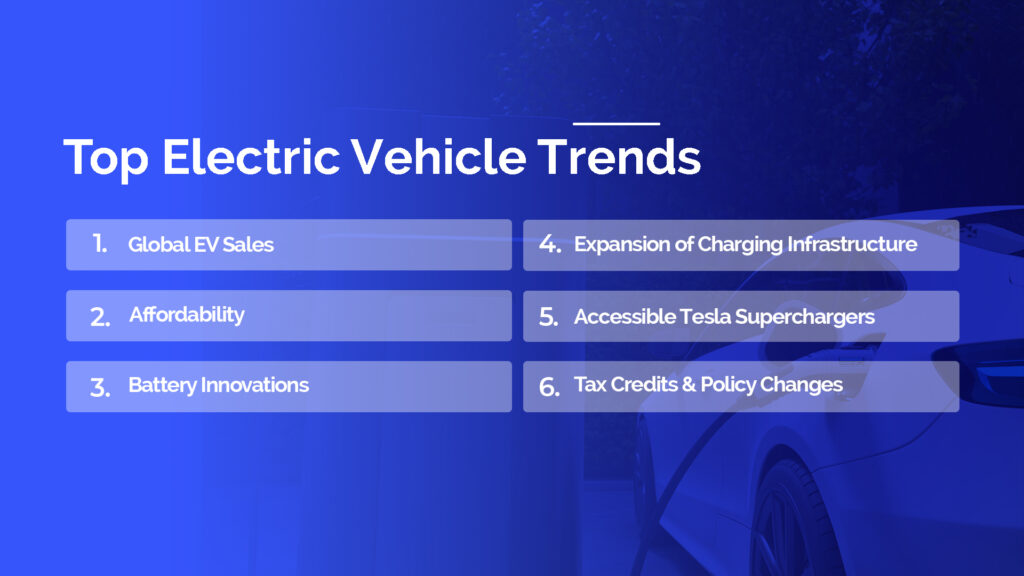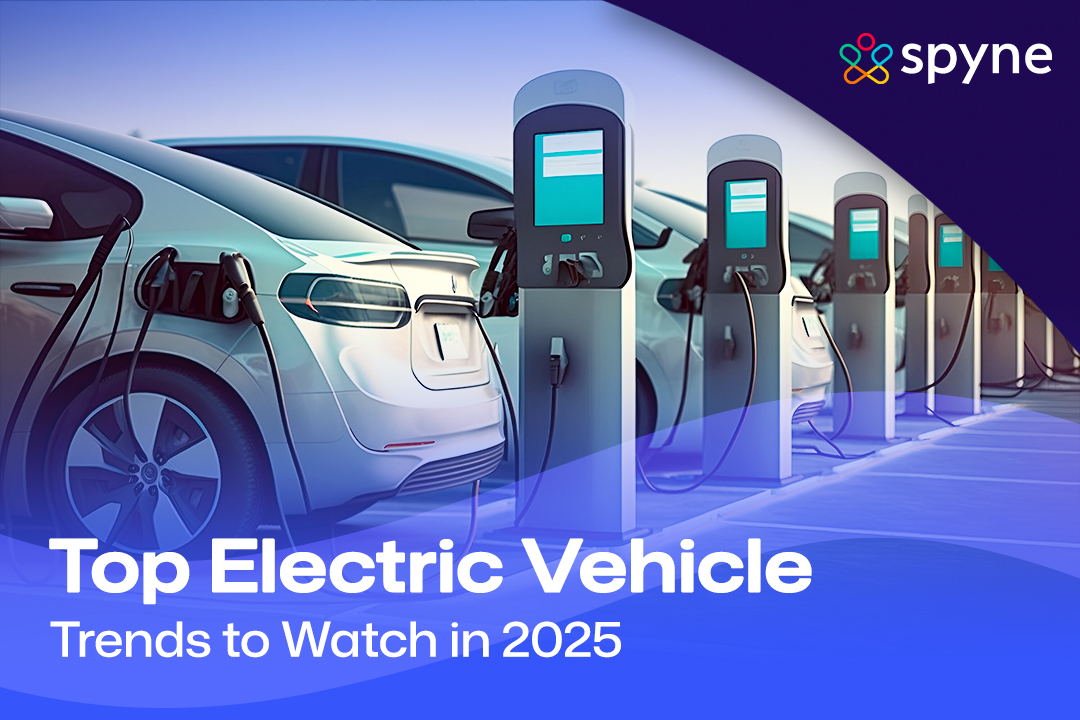Over the past decade, the electric vehicle (EV) industry has seen rapid growth, thanks to technological advancements and government incentives, and has become a pivotal player in the automotive industry. As electric car sales continue to boom and battery technology advances, the future of electric mobility looks bright. The EV driving experience is not just limited to environmental benefits, but also to the low maintenance and quiet operation.
As we head into the second half of 2025, significant changes are taking place in the EV industry and transportation electrification. Some of the electric vehicle trends for 2025 include lower electric car prices, an expansion of charging stations, and greater charging plug compatibility. In this blog, let us explore the latest trends for 2025 and how they are shaping the electric vehicle trends in the industry this year.

1. EV Sales Trends: Global Electric Vehicle Sales Continue to Surge
One of the electric vehicle trends is that the sales are forecasted to reach a staggering 85 million units globally in 2025, marking a pivotal milestone in the transition from internal combustion engines to EV cars.
- China is leading the way, expected to account for over 60% of global EV sales, with electric vehicles making up 35% of all new car sales in the country.
- Europe and North America follow closely, backed by strong government incentives, increasing infrastructure, and rising public interest.
Key drivers of this growth include lower prices, improved vehicle inspection systems ensuring quality and safety, and extended range capabilities. This convergence of accessibility and innovation is drawing more people into the EV market than ever before, becoming one of the most sought-after electric vehicle trends.
2. Lower EV Prices Make Electric Cars More Accessible
Affordability is reshaping the car segment in 2025. Many electric cars are now priced under $40,000, especially when federal tax credits in the U.S. are applied.
While the Trump administration may bring uncertainty to national EV incentives, declining battery costs continue to reduce electric car prices. Since batteries account for about 40% of a vehicle’s cost, advancements in production efficiency, raw materials, and augmented reality in car manufacturing are helping cut expenses and improve quality.
3. Battery Innovations Reshape the EV Market
At the forefront of electric vehicle trends in 2025 stands battery tech advancements that are shaping the future of EV innovation. Automakers and researchers alike are focusing on the development of solid-state batteries and improving the already-existing lithium-ion batteries. These gains, paired with augmented reality automotive simulations used in prototyping, are speeding up development and adoption.
Toyota is at the forefront, developing solid-state batteries with a 750-mile range, targeted for commercial release in 2026–2027. As these technologies scale, EV cars will offer longer ranges at lower prices, accelerating adoption across markets.
More focus is on the ongoing reduction in battery costs. Automakers are lowering battery prices through advances in materials, scaling production, and manufacturing processes. Since batteries account for at least 40% of an EV’s total cost, these reductions help make EVs more affordable for consumers. As improved battery longevity is a priority, the combination of efficiency, affordability, and performance continues to drive the demand for EVs forward, making it an electric vehicle trend you should keep an eye on.
4. Charging Infrastructure Expands Nationwide
Access to reliable and fast charging remains one of the biggest barriers to EV adoption. In 2025, investments from both the public and private sectors are expanding EV charging networks, from urban centers to rural highways.
Key 2025 EV trends in charging infrastructure include:
- Ultra-fast chargers that dramatically reduce wait times
- Integration of renewable energy sources (solar and wind)
- Growth of bidirectional charging (Vehicle-to-Grid or V2G) capabilities
V2G technology is especially transformative, enabling EVs like the Ford F-150 Lightning to supply power back to the grid or act as home backup power. These improvements also benefit from car rendering tools that visualize charging station deployment, ensuring better planning and execution in dense and rural areas alike.
5. Tesla Superchargers Open to All EVs
For years, Tesla Superchargers were exclusive to Tesla drivers. In 2025, the company has opened access to non-Tesla EV cars, using adapters or through standard connectors.
This change is game-changing, significantly reducing range anxiety and increasing confidence in electric car travel, a win for all drivers in the EV market.
6. Tax Credits & Policy Changes Reshape Buyer Incentives
For electric cars, federal tax credit policies are evolving and the new guidelines are assessing eligibility on a per-vehicle basis, requiring income caps to target middle and lower-income households, U.S. assembly and battery sourcing, and automaker submission of VIN numbers to the IRS. Shoppers are further required to consult the U.S. Treasury Department list to confirm their vehicle’s eligibility.
EVs Eligible for the $7,500 Tax Credit in 2025:
- Chevrolet Bolt EUV
- Chevrolet Blazer EV
- Ford F-150 Lightning
- Tesla Model 3 Performance
- Tesla Model X Long Range
- Tesla Model Y
- Volkswagen ID.4
EVs Eligible for the $3,750 Tax Credit in 2025:
- Ford Escape Plug-In Hybrid
- Jeep Grand Cherokee 4xe
- Jeep Wrangler 4xe
- Lincoln Corsair Grand Touring
- Nissan Leaf
- Rivian R1S and R1T
Opportunities for EV Contractors & Installers
Electric vehicle trends and sales are rising, and there is a significant demand for EV charging station installers. The infrastructure is expanding, and so are the opportunities for electricians and contractors. A few challenges remain, like navigating complex permitting and zoning codes and staying current in the ever-evolving EV charging standards. The 2025 landscape offers enormous potential for skilled tradespeople, mainly through partnerships with EV automakers and platforms like GreenLancer.
Conclusion: The Road Ahead for EV Cars in 2025
The electric vehicle industry is growing and entering a new era in 2025, so are the electric vehicle trends. With a strong EV market share growth, declining prices, strong battery technology, and expanded infrastructure, electric cars are no longer just a vision of the future but a present reality.
Whether you are a buyer, a business, a contractor, or just interested in sustainability, staying informed on the latest vehicle trends is crucial. This helps in navigating the changing automotive industry. As electric car sales continue to rise, 2025 is shaping up to be a landmark year for the EV market and the transition to a greener, more sustainable future.
















